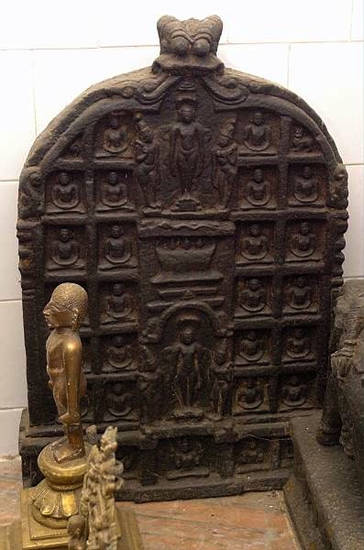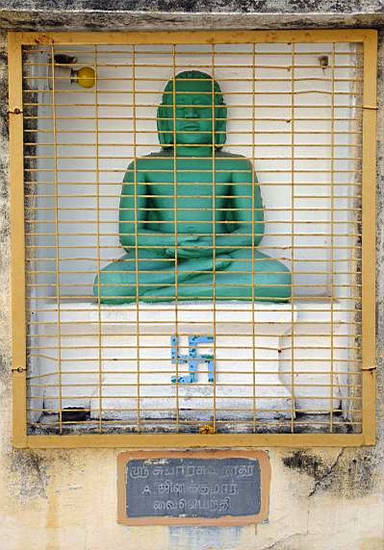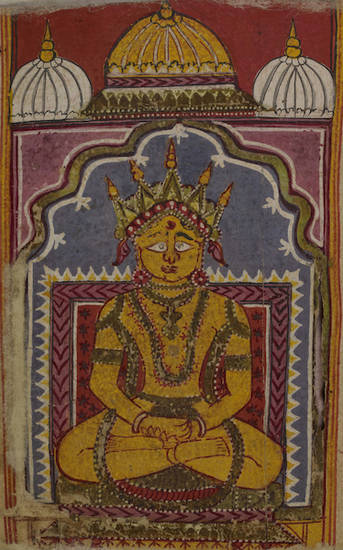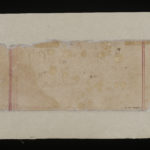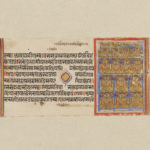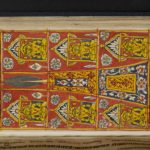Article: Supārśva
Supārśvanātha or Lord Supārśva is the seventh of the 24 Jinas of the present cycle of time. The word Jina means ‘victor’ in Sanskrit. A Jina is an enlightened human being who has triumphed over karma through practising extreme asceticism and teaches the way to achieve liberation. A Jina is also called a Tīrthaṃkara or ‘ford-maker’ in Sanskrit – that is, one who has founded a community after reaching omniscience.
Supārśva is not an historical figure. He is not singled out for individual biographies in the Śvetāmbara canonical scriptures. Treated like most of the other Jinas, he is provided only with basic biographical information. This information is fairly standardised and remains identical throughout later sources except for occasional variations, or confusions, in numbers.
The meaning of his name is literally ‘having beautiful flanks’, which has positive connotations because it refers to the physical perfection of a Jina. The name Supārśva is connected with that of the 23rd Jina, Pārśvanātha or Lord Pārśva. Indeed, these two Jinas have a number of features in common, specifically their:
- name
- place of birth
- association with snakes.
Thus Supārśva appears as ‘a double of Pārśva’ (Bruhn 1969: 220).
There are minor differences between the accounts and descriptions of this Jina among the two main Jain sects. According to Śvetāmbara biographies, Supārśva married princesses and governed the earth as a king before leaving worldly life for monastic initiation. According to the sect of the Digambaras, none of the Jinas assumed the responsibilities of a householder or king before becoming monks.
Basic information

A Jina meditating, probably Supārśva
Image by British Library © CC0 1.0 (Creative Commons Public Domain)
Each Jina has standard biographical information found in various sources. Among the earliest Śvetāmbara canonical sources that provide biodata of the 24 Jinas is the final section of the fourth Aṅga, the Samavāyānga-sūtra and the Āvaśyaka-niryukti. Among the earliest of the Digambara sources is a cosmological work, the Tiloya-paṇṇatti.
The standard Digambara biography of Supārśvanātha or Lord Supārśva is found on pages 39 to 44 of the 1968 edition of Guṇabhadra’s Uttarapurāṇa in Sanskrit and Hindi. The standard Śvetāmbara biography is on pages 303 to 313 in volume II of Johnson’s English translation of Hemacandra’s work, Tri-ṣaṣṭi-śalākāpuruṣa-caritra.
The biographical data can be categorised in a standard manner, and includes numbers, which are significant in wider Indian culture. These standard details can also be used to identify individual Jinas in art, since they are usually depicted as stereotyped figures. Pictures or statues of Jinas present them in either the lotus position or the kāyotsarga pose. Both of these imply deep meditation.
Parents
The important feature of a Jina’s father is that he is a king, from the kṣatriyacaste.
A Jina’s mother has an important role because she gives birth to a future Jina, and in practice a Jina is often called ‘the son of X’. Another reason for her importance is that the names given to the various Jinas are said to originate either in pregnancy-whims or in a dream their mothers had, at least in Śvetāmbara sources. This dream is specific, and adds to the traditional auspicious dreams that foretell the birth of a child who will become a Jina.
In the case of Supārśvanātha or Lord Supārśva, Śvetāmbara sources state that this name was given to him for a reason connected with the time of his mother’s pregnancy. Hemacandra relates that his father gave the baby this name because his mother was ‘beautiful-sided’ – su-pārśvā – while he was in her womb (Johnson’s translation of Hemacandra, Triṣaṣṭi-śalākā-puruṣa-carita, volume II, page 307). In doing this, he follows the traditional explanation provided earlier in the Āvaśyaka-niryukti, a Prakrit scripture which gives explanations for each of the 24 Jinas’ names.
|
Mother |
Father |
|---|---|
|
Pṛthvī – Śvetāmbara |
Pratiṣṭha or Supratiṣṭha |
Places
Of the five auspicious events that mark a Jina’s life – kalyāṇakas – four take place on earth and are associated with a specific village or town in the sources. Archaeological evidence often helps to identify the old names with modern places. Even when it is lacking, there is a tendency to carry out this identification process. Associating auspicious events with certain locations makes these places sacred to Jains, so that they are potential or actual pilgrimage places and temple sites.
|
Last incarnation and birthplace |
||
|---|---|---|
|
Vārāṇasī |
Vārāṇasī, Sahasrāmravana |
The traditional association of Supārśvanātha or Lord Supārśva with Vārāṇasī – modern Banaras – in Uttar Pradesh, is recorded, for instance, in the Vividha-tīrtha-kalpa, a 14th-century work on sacred places by the Śvetāmbara monk Jinaprabha-sūri. It is also the birthplace of the 23rd Jina, Pārśvanātha or Lord Pārśva.
The exact place where Supārśva was born is supposed to be ‘Bhadaini Muhallah’, a part of Banaras situated near the bank of the Ganges and known as the ‘Jain ghat’. It is located at about 1.5 kilometres from Bhelupura.
Today, the site is a place of worship for both Śvetāmbaras and Digambaras, who have each installed a different image of the seventh Jina in their respective temples. The Śvetāmbaras’ idol is white and is 68 centimetres tall while that of the Digambaras is black and 46 centimetres tall.
Dates and numbers
The five auspicious events that mark a Jina’s life – kalyāṇakas – are traditionally associated with a specific date. This is given according to the system of the Indian calendar:
- month
- fortnight
- day in the fortnight.
Astrological considerations also play a role here and the texts normally mention the constellations when an auspicious event takes place.
|
Last incarnation |
Birth |
|||
|---|---|---|---|---|
|
eighth day of the dark half of Bhādrapada – Śvetāmbara |
12th day of the bright half of Jyeṣṭha |
13th day of the bright half of Jyeṣṭha – Śvetāmbara |
sixth day of the dark half of Phālguna |
seventh day of the dark half of Phālguna |
The dates associated with these events are potential or actual dates of commemoration. These may be marked in festivals, which determine the Jain religious calendar.
There may be variations in the dates in different sources, Śvetāmbara on one side, Digambara on the other. But there are also cases of differences within the same sectarian tradition.
There are also other numbers connected with the life of this Jina.
|
Height |
Total lifespan |
|---|---|
|
200 bows |
2,000,000 pūrvas |
Monastic and lay communities
A Jina is not an enlightened being who exists alone after reaching omniscience. After perfect knowledge comes general preaching – samavasaraṇa. This sermon, which is attended by all, is reported in the scriptures as resulting in large numbers of listeners being inspired. Many turn to religious life, becoming monks or nuns, while many others make the vows that lay people – śrāvaka and śrāvikā – can follow in their everyday lives. Furthermore, the Jina’s teachings are preserved and passed on by his chief disciples – the gaṇadharas. This is why a Jina is also called a Tīrthaṃkara, meaning ‘ford-maker’ or ‘founder of a community’.
Each Jina establishes a ‘fourfold community‘, led by the chief disciples. Made up of monks, nuns, lay men and lay women, the fourfold community follows the principles the Jina has set out in his preaching. How members follow the religious teachings vary according to whether they remain householders or become initiated into mendicancy. Individual figures relating to each Jina are thus important.
|
Chief disciples |
Lay men |
Lay women |
||
|---|---|---|---|---|
|
95, led by Vidarbha – Śvetāmbara |
300,000 |
430,000 led by Somā or Sumanā – Śvetāmbara |
257,000 |
493,000 |
Identification and association with snakes
All Jinas have individual emblems – lāñchanas – and colours that help to identify them in artwork. They also have attendant deities known as yakṣa and yakṣī, who often appear flanking them in art.
|
Colour |
Emblem |
||
|---|---|---|---|
|
gold – Śvetāmbara |
Mātanga – Śvetāmbara |
Śāntadevī – Śvetāmbara |
Supārśvanātha or Lord Supārśva is also one of the few Jinas whose iconography is distinctive, as he is often – but not always – shown with snakehoods above his head. This association with snakes is stated, for instance, in the standard biography of this Jina as narrated by Hemacandra in the Triṣaṣṭi-śalākā-puruṣa-caritra. It is said to go back to the time when the Jina-to-be was an embryo:
The Queen [dreamed she] saw herself asleep on a couch of serpents which had one hood, five hoods, and nine hoods
Johnson’s translation, volume II, page 308
In the account of this Jina’s general preaching following his attainment of omniscience – the samavasaraṇa – the god Śakra creates snakes over Supārśva’s head that are reminiscent of those his mother saw in her dream. This is narrated as something which then became characteristic of all samavasaraṇas.
The antiquity of this association, however, is unknown. No reference to it is found either in early sources or in another Śvetāmbara biography of this Jina, the Cauppaṇṇa-mahāpurisa-cariya, written in the ninth century by Śīlānka. Nor is there a mention in the Digambara version in Guṇabhadra’s Uttarapurāṇa. It is likely that this association, which is so important in the case of the 23rd Jina, Pārśvanātha or Lord Pārśva, was carried over to Supārśva because of the similarity of their names.
In theory, the snakes are shown above the head for Supārśva, and behind the body for Pārśva, but this distinction is far from being observed everywhere. In many cases it is thus difficult to distinguish between depictions of the two Jinas when there are no personal emblems or inscriptions.
The number of snakehoods is theoretically different for both, namely:
- Supārśva – one, five or nine
- Pārśva – three or seven.
But, again, this principle is not followed strictly in available images. For instance there are Pārśva images with five snakehoods and Supārśva images with no snakehood at all.
More details
Besides the basic information, the sources provide more details on various topics. These are almost infinite and vary depending on the sources. Such information differs between Śvetāmbaras and Digambaras. Here are only a few instances of extra detail.
All of the princes who become Jinas are carried on a palanquin to the park where they perform the ritual gesture of initiation into monastic life – dīkṣā. The palanquin of Supārśvanātha or Lord Supārśva is named Manoharā. On this occasion, he is accompanied by numerous kings.
He performs a two-day fast. The next day he breaks his fast at the house of King Mahendra in the town of Pāṭalīkhaṇḍa.
Supārśva wanders for nine months as an ordinary ascetic and reaches omniscience under a śirīṣa tree.
Events, stories and hymns
The life of Supārśvanātha or Lord Supārśva is not rich in events. In the ninth-century Lives of the 54 Jain Great Men – Cauppaṇṇa-mahāpurisa-cariya – written in Prakrit by the Śvetāmbara monk Śīlānka, the chapter about the seventh Jina has a little more than one page.
The 12th-century Sanskrit text Tri-ṣaṣṭi-śalākā-puruṣa-caritra, written by Hemacandra, is also short.
Even so, there are several sizeable biographies focusing on the seventh Jina. Among them the most famous and most important is the Prakrit Supāsa-nāha-cariya.
Supāsa-nāha-cariya
With about 8,700 stanzas in Sanskrit, the Supāsa-nāha-cariya was written in 1142 CE (1199 of the Vikrama era) by the monk Lakṣmaṇa-gaṇi, pupil of Hemacandra-sūri of the Harṣapurīya-gaccha monastic order. The text is divided into three chapters (Chaudhari 1973: 81–82).
The first one narrates at length the previous births of the future seventh Jina as a human being or god. It explains how he gained the category of karma that implies he would become a Tīrthaṃkara – Tīrthaṃkara-nāma-karman.
The second chapter narrates Supārśva’s birth, marriage and initiation into monastic life.
The third one presents the Jina’s attainment of omniscience and is also an extensive exposition of various ascetic practices and postures. It is supplemented with a number of sermons and intervening stories which cover:
An illustrated manuscript of this work, covering 443 folios and written in 1422 CE (1479 of the Vikrama era) in Delavada in Mewar, Rajasthan, has 37 lively and colourful paintings (list in Punyavijaya 1956). Some of them are reproduced in Muni Punyavijaya’s article and a few also in the book New Documents of Jaina Painting (Moti Chandra and U. P. Shah 1975).
Hymns
Supārśva is mainly praised alongside other Jinas in hymns dedicated to the 24 Jinas. One instance is the devotional song dedicated to this Jina in the Gujarati set of hymns composed by Yaśo-vijaya in the 17th century. This example can be found among the manuscripts digitised on JAINpedia.
Temples and images
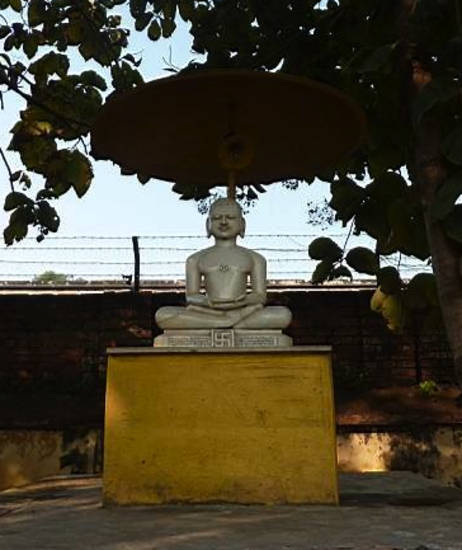
Supārśva
Image by Nalini Balbir © Nalini Balbir
Supārśvanātha or Lord Supārśva is quite popular. As mentioned above, there is some amount of confusion between Supārśva and the 23rd Jina Pārśvanātha or Lord Pārśva. Thus there may be many more images available of the former than thought at first sight.
Supārśva is known through a number of stone sculptures (Shah 1987: 139–142), such as:
- those in cave 8 and 9 at Khanda-giri, in Orissa
- the standing marble image in the Jain temple at Pālaḍī, a few miles from Sirohi in Rajasthan, which shows him with five snakehoods, identified from the inscription dated 1291 CE
- the mutilated standing image with five snakehoods and the svastika in the Neminātha temple at Kumbharia, north Gujarat
- the standing images in temples number 5 and 28 at Khajuraho, Madhya Pradesh, which have five snakehoods, with the latter figure also showing the emblem of this Jina, the svastika.
Metal images showing Supārśva alone or with other Jinas are also available in temples and museums.
Reading
- Jaina Sāhitya kā Bṛhad Itihāsa
Gulabccandra Chaudhari - Kāvya-sāhitya series; volume 6
Parshvanath Vidyashram Shodh Samsthan; Varanasi, Uttar Pradesh, India; 1973
- New Documents of Jaina Painting
Moti Chandra and Umakant P. Shah - Shri Mahavira Jaina Vidyalaya Publication; Bombay, Maharashtra, India; 1975
- Jaina Temple Architecture in India: The Development of a Distinct Language in Space and Ritual
Julia A. B. Hegewald - Monographien zur Indischen Archäologie, Kunst und Philologie series; volume 19
Stiftung Ernst Waldschmidt, G+H Verlag; Berlin, Germany; 2009
- Vividhatīrthakalpa
Jinaprabhasūri - edited by Muni Jinavijaya
Singhi Jain series; volume 10
Shantiniketan; Bombay, India; 1934
- ‘Supāsanāhacariyaṃ nī hastalikhita pothī māṃ nā raṃgīna citro’
Muni Puṇyavijaya - Śrī Vijaya Vallabha-Sūri Smāraka Grantha
Mahāvīra Jaina Vidyālaya; Bombay, Maharashtra, India; 1956
- Supāsaṇāhacariaṃ
Lakṣmaṇa-gaṇi - Jinaśāsana Ārādhanā Trust; Bombay, Maharashtra, India; 1989
- The Jain Saga: 63 Illustrious Persons of the Jain World, Brief History of Jainism
Hemacandra - translated by Helen M. Johnson
edited by Muni Samvegayashvijayji Maharaj
Acharya Shrimad Vijay Ramchandra Suriswarji Jain Pathshala; Ahmedabad, Gujarat and Mumbai, Maharashtra, India; 2009
Links
- +
- aAbhavya
- aAbhinandana
- aAbhiṣeka
- aĀcāra
- aĀcārāṅga-sūtra
- aĀcārya
- aAchalbhrata
- aAḍhāī-dvīpa
- aAdharma
- aAdho-loka
- aAdhyayana
- aAdvaita Vedānta
- aĀgama
- aAghātīya
- aAghātīya-karman
- aAgnibhuti
- aAgra
- aĀhāra
- aAhiṃsā
- aAhimsa Day
- aAjita
- aAjīva
- aAkampit
- aĀkāśa
- aAkbar the Great
- aAkṣaya-tṛtīyā
- aAlauddin Khalji
- aAlbert Einstein
- aAllah
- aAlms
- aĀlocanā
- aAloka-ākāśa
- aAmāri
- aAmbikā or Kūṣmāṇḍinī
- aAnagāra
- aAnanta
- aAnarthadaṇḍa
- aAnaśana
- aAnekānta-vāda
- aAṅga
- aAniconism
- aAnojjā
- aAntarāla
- aAntarāya-karma
- aAṇu
- aAṇu-vrata
- aAnukampā
- aAnuprekṣā
- aAnusvāra
- aApabhraṃśa
- aAparigraha
- aAra
- aĀrambha
- aĀrambhaja
- aĀratī
- aArdhamāgadhī Prākrit
- aArhaṃ
- aArhat
- aArśana-āvaraṇīya-karma
- aĀrta-dhyāna
- aĀryikā
- aĀryikā Jñānamati
- aĀśātanā
- aĀścarya
- aAscetic
- aAsceticism
- aAshram
- aAspiration
- aĀsrava
- aAṣṭa-maṅgala
- aAṣṭāpada
- aAstikāya
- aAstrolabe
- aAsura
- aAtheism
- aAticāra
- aAtiśayakṣetra
- aAtithisaṃvibhāgavrata
- aĀtma-vāda
- aĀtman
- aAuṃ
- aAurangzeb
- aAuspicious
- aAusterity
- aAvadhāna
- aAvadhi-jñāna
- aĀvaraṇī-yakarman
- aAvasarpiṇī
- aAvatāra
- aAvidyā
- aAxiom
- aĀyāga-paṭa
- aĀyambil
- aĀyu-karma
- aĀyurveda
- bBabur
- bBāhubali
- bBaladeva
- bBālāvabodha
- bBandha
- bBasadi
- bBazaar
- bBhadrankarvijay
- bBhagavant
- bBhaktāmara-stotra
- bBhakti
- bBhale
- bBharata
- bBhāṣā
- bBhāṣya
- bBhaṭṭāraka
- bBhāva
- bBhāva-pūjā
- bBhāvanā
- bBhavana-vāsin
- bBhavya
- bBhavyatva
- bBhaya
- bBhoga-bhūmi
- bBhogopabhoga
- bBodhi
- bBollywood
- bBrahmā
- bBrahma-deva
- bBrahmacārī
- bBrāhmaṇa
- bBraj Bhāṣā
- bBright fortnight
- bBritish Raj
- bBuddha
- bBuddhi-sagar
- bBuddhism
- bBuddhist
- cCaitya
- cCaityavāsin
- cCakravartin
- cCakreśvarī
- cCāmara
- cCandanā
- cCandragupta
- cCandraprabha
- cCanon
- cCāritra
- cCāritramohanīya-karman
- cCarũrī
- cCaste
- cCaturvidha-saṅgha
- cCaturviṃśati-stava
- cCāturyāma
- cCE
- cCelibacy
- cCha
- cChadmastha
- cChastity
- cCheda-sūtra
- cChristian
- cChristianity
- cClergy
- cCloning
- cColophon
- cCommentary
- cConch
- cConfession
- cCongregation
- cConsecration
- cCosmology
- cCremation
- cCrore
- cCult
- cCūrṇi
- dDādā-guru
- dDalit
- dDāna
- dDaṇḍa
- dDark fortnight
- dDarśana
- dDarśanamohanī-yakarman
- dDaśa-lakṣaṇa-parvan
- dDeity
- dDelhi Sultanate
- dDerāsar
- dDeśāvakāśika-vrata
- dDetachment
- dDevanāgarī
- dDevānandā
- dDevarddhi-gani
- dDevotee
- dDhamal
- dDhanuṣ
- dDhāra
- dDharma
- dDharma-dhyāna
- dDharma-sāgara
- dDharmastikaya
- dDhātakīkhaṇḍa
- dDholak
- dDhyāna
- dDiaspora
- dDig-vrata
- dDigambara
- dDīkṣā
- dDisciple
- dDīvālī
- dDivya-dhvani
- dDNA
- dDoctrine
- dDogma
- dDonor
- dDoṣa
- dDravya
- dDravya-pūjā
- dDrone
- dDuṣamā
- dDuṣamā-duṣamā
- dDuṣamā-suṣamā
- dDveṣa
- dDvīpa
- eEast India Company
- eEightfold Path
- eEkānta-vāda
- eEkendriya
- eElder
- eElders
- eEschatology
- eEtc up to
- fFarmān
- fFast
- fFatehpur Sikri
- fFestival
- fFestschrift
- fFiruz Shah
- fFly-Whisks
- fFolio
- fFour Noble Truths
- gGaccha
- gGaṇa
- gGaṇadhara
- gGanadharavada
- gGaṇeśa
- gGaṇin
- gGarba
- gGarbha
- gGarbha-gṛha
- gGaruḍa
- gGati
- gGene
- gGenomics
- gGhātī-yakarman
- gGhātīya
- gGhaznavid
- gGhiyasuddin Tughlaq
- gGhurid
- gGloss
- gGotra-karma
- gGujarāt
- gGujarati
- gGuṇa
- gGuṇa-sthāna
- gGuṇa-vrata
- gGupti
- gGuru
- gGuruṇī
- hHagiography
- hHajj
- hHaṃsa
- hHaribhadra
- hHariṇaigameṣin
- hHasta
- hHeresy
- hHiṃsā
- hHindi
- hHindu
- hHinduism
- hHīravijaya
- hHoroscope
- hHrīṃ
- hHumayun
- hHymn
- iIconoclasm
- iIconography
- iIdol
- iIndian Independence
- iIndology
- iIndra
- iIndrabhūti Gautama
- iIndriya
- iInitiation
- iIntercession
- iInvocation
- iIQ
- iIslam
- iIslamicate
- iIṣṭadevatā
- iĪśvara
- jJagat
- jJahangir
- jJain
- jJaina Devanāgarī
- jJaina Śaurasenī
- jJaina-dharma
- jJainaśāsana
- jJainness
- jJaisalmer
- jJamāli
- jJambū-dvīpa
- jJames Burgess
- jJanma
- jJanma-kalyāṇa
- jJarā
- jJāti
- jJina
- jJina-āgama
- jJina-bhavana
- jJina-bimba
- jJina-mātā
- jJinacandra-sūri
- jJinadatta
- jJinaprabha
- jJīva
- jJñāna
- jJñāna-āvaraṇīya-karma
- jJñāna-āvarṇiya
- jJñānsundar
- jJyotiṣka
- kKāla
- kKālakācārya-kathā
- kKālidāsa
- kKalpa-sūtra
- kKalpa-vṛkṣa
- kKalyāṇaka
- kKalyanvijay
- kKamaṇḍalu
- kKamaṭha
- kKarma
- kKarma-bhūmi
- kKarma-grantha
- kKarma-prakṛti
- kKarma-vāda
- kKarmon
- kKarnataka
- kKaṣāya
- kKathā
- kKāvya
- kKāya
- kKāyotsarga
- kKeśa-loca
- kKetu
- kKevala-jñāna
- kKevalin
- kKhalji
- kKharatara-gaccha
- kKnowledge
- kKriyā
- kKriyā-vāda
- kKṛṣṇa
- kKṣamā-śramaṇa
- kKṣapakaśreṇi
- kKṣatriya
- kKṣullaka
- kKulakara
- kKundakunda
- kKunthu
- lLabdhi
- lLaity
- lLakh
- lLāñchana
- lLands of Action
- lLaukāntika
- lLavaṇa-samudra
- lLeśyā
- lLiṅga
- lLinguistics
- lLoka
- lLoka-ākāśa
- lLoka-puruṣa
- lLoka-vāda
- lLotus
- lLotus lake
- mMadhya-loka
- mMahā-videha
- mMahā-vrata
- mMahābhārata
- mMahāmastakābhiṣeka
- mMāhārāṣṭra
- mMāhārāṣṭrī Prākrit
- mMahattarā Yākinī
- mMahāvīr Jayantī
- mMahāvīra
- mMakāra
- mMakkhali Gośāla
- mMalli
- mMāna-stambha
- mManaḥ-paryāya-jñāna
- mMaṇḍala
- mMaṇḍapa
- mMandit
- mMaṅgala
- mMantra
- mMantras
- mManuṣya-loka
- mMarāṭhī
- mMārgaṇā
- mMartyr
- mMarudevī
- mMaṭha
- mMati-jñāna
- mMauryaputra
- mMecca
- mMendicant lineage
- mMetarya
- mMiracle
- mMithyādṛṣṭi
- mMohandas Gandhi
- mMohanīya-karma
- mMokṣa
- mMonastic order
- mMonasticism
- mMonk
- mMonotheism
- mMosque
- mMount Meru
- mMount Sammeta
- mMṛgāvatī
- mMughal
- mMuhammad
- mMuhammad bin Tughlaq
- mMuhpattī
- mMūla-sūtra
- mMūlaguṇa
- mMumbaī
- mMuni
- mMunisuvrata
- mMurad Bakhsh
- mMūrti-pūjaka
- mMuslim
- mMysticism
- nNābhi
- nNāga-kal
- nNāgapurīya Tapā-gaccha
- nNāgarī
- nNāma-karma
- nNamaskāra-mantra
- nNami
- nNandīśvara-dvīpa
- nNandivardhana
- nNandyāvarta
- nNāraka
- nNāraki
- nNasalisation
- nNātha
- nNavrātrī
- nNaya-vāda
- nNemi
- nNidāna
- nniggaṃthāṇa vā 2
- nniggaṃtho vā 2
- nNigoda
- nNihnava
- nNikṣepa
- nNirgrantha
- nNirjarā
- nNirvāṇa
- nNiryukti
- nNiṣidhi
- nNitya
- nNiyati
- nNo-kaṣāya
- nNudity
- nNun
- oOcean of milk
- oOmniscience
- oOrdination
- ppa°
- pPadmaprabha
- pPadmāsana
- pPadmāvatī
- pPādukā
- pPalanquin
- pPalette
- pPañca-muṣṭi
- pPāṇḍava
- pPaṇḍit
- pPandit Dalsukh D. Malvania
- pPandit Sukhlalji
- pPāṇipātra
- pPāpa
- pParamātman
- pParameṣṭhin
- pPāraṇā
- pParigraha
- pPariṇāma
- pParīṣaha
- pParokṣa
- pPārśva
- pPārśvanātha
- pParyāya
- pParyuṣaṇ
- pPaṭa
- pPatan
- pPātra
- pPenance
- pPersian
- pPhala
- pPhilology
- pPicchikā
- pPilgrimage
- pPīr
- pPolymath
- pPoṣadha
- pPossession
- pPothī
- pPrabhas
- pPradakṣiṇā
- pPradeśa
- pPrākāra
- pPrakīrṇaka-sūtra
- pPrākrit
- pPramāda
- pPramukhā
- pPrati-vāsudeva
- pPratikramaṇa
- pPratimā
- pPratiṣṭhā
- pPratyākhyāna
- pPratyakṣa
- pPravacana
- pPrāyaścitta
- pPrayer
- pPre-modern
- pPreach
- pPredestination
- pProtestant
- pProvenance
- pPudgala
- pPūjā
- pPujārī
- pPukharavara-dvīpa
- pPuṇya
- pPūrva
- pPuṣkara-dvīpa
- pPuṣpadanta
- pPyre
- qQur’an
- rRāga
- rRāhu
- rRainy season
- rRajasthan
- rRajasthani
- rRājimatī
- rRajoharaṇa
- rRajput
- rRāma
- rRāmāyaṇa
- rRangoli
- rRās-garbā
- rRasa
- rRathanemi
- rRatna-traya
- rRātri-bhojana
- rRaudra-dhyāna
- rRecto
- rRelic
- rRenunciation
- rRetroflex
- rRevatī
- %Ṛg-veda
- rRite
- rRosary
- %Ṛṣabha
- %Ṛṣabhanātha
- rRupee
- sSaciyā Mātā
- sSādhu
- sSādhvī
- sSāgāra
- sSaint
- sŚaivaism
- sŚaka-saṃvat
- sSallekhanā
- sŚalya
- sSamacatuṣṭha
- sSamādhimaraṇa
- sSamaṇi
- sSāmarambha
- sSamavasaraṇa
- sSāmāyika
- sSaṃbhava
- sSamiti
- sSaṃjñā
- sSaṃkalpaja
- sSaṃsāra
- sSamudghāta
- sSaṃvara
- sSaṃvega
- sSamyak-cāritra
- sSamyak-darśana
- sSamyak-jñāna
- sSamyaktva
- sSaṃyama
- sSanctuary
- sSandalwood
- sSaṇgha
- sSanskrit
- sSant
- sŚānti
- sSapta-bhaṅgi-naya
- sSārambha
- sSarasvatī
- sSarvajña
- sSāsan-devi
- sŚāsana-devatā
- sŚāstra
- %Ṣaṭ-jīvanikāya
- sSatī
- sSatīmātā
- sSatya
- sSchism
- sScribe
- sScripture
- sSect
- sSecularism
- sŚenāī
- sSermon
- sŚeṣavatī
- sSevā
- sSeven fields of donation
- sShah Jahan
- sShantidas Jhaveri
- sShrine
- sSiddha
- sSiddha-śilā
- sSiddhacakra or Navadevatā
- sSiddhānta
- sSiddhārtha
- sSiddhi
- sSikh
- sSikhism
- sŚikṣā-vrata
- sŚīla
- sSin
- sSindh
- sŚītala
- sŚiva
- sSkandha
- sSomanatha
- sŚraddhā
- sŚramaṇa
- sŚrāvaka
- sŚrāvakācāra
- sŚrāvikā
- sŚreyāṃsa
- sŚrī
- sŚrīvatsa
- sŚruta-jñāna
- sŚruta-pañcamī
- sSthānaka-vāsin
- sSthāpanācārya
- sSthāvara
- sSthavira
- sSthiti
- sStrīmukti
- sStūpa
- sSubcontinent
- sSudarshana
- sŚuddhi
- sSudharma
- sŚūdra
- sSufism
- sSukha
- sŚukla-dhyāna
- sSulasā
- sSultan
- sSumati
- sSundarśrī
- sSupārśva
- sSūri
- sSuṣamā
- sSuṣamā-duṣamā
- sSuṣamā-suṣamā
- sSūtra
- sSuyam me ausam! Tenam bhagavaya evamakkhayam
- sSvādhyāya
- sSvāhā
- sSvastika
- sŚvetāmbara
- sŚvetāmbara Terāpanthin
- sŚvetāmbaras
- sSwan
- sSyād-vāda
- tTabla
- tTantra
- tTapā-gaccha
- tTapas
- tTāraṇ Svāmī Panth
- tTattva
- tTattvārtha-sūtra
- tTemple
- tTemple-city
- tThe Enlightenment
- tTheology
- tThree worlds
- %Ṭīkā
- tTilaka
- tTīrtha
- tTīrthaṃkaranāma-karman
- tTīrthankara
- tTransliteration
- tTrasa
- tTrasa-nāḍī
- tTriśalā
- tTriṣaṣṭi-śalākā-puruṣa-caritra
- tTti bemi
- tTughlaq
- tTunk
- uUdumbara
- uUniversal History
- uUpādhyāya
- uUpāṅga
- uUpaniṣads
- uUpāsaka
- uUpasarga
- uUpāśraya
- uŪrdhva-loka
- uUtsarpiṇī
- uUttarādhyayana-sūtra
- vVāhana
- vVaimānika
- vVairāgya
- vVaiṣṇava
- vVaiśramaṇa
- vVaiśya
- vValabhī
- vVanaspatikāya
- vVandana
- vVaṇik
- vVarṇa
- vVāsudeva
- vVāsupūjya
- vVayubhūti
- vVeda
- vVedanīya-karma
- vVegetarianism
- vVehicle
- vVernacular
- vVerso
- vVidyā
- vVidyā-devī
- vVihāra
- vVijñapti-patra
- vVikrama-saṃvat
- vVikṛti
- vVimala
- vVinaya
- vVipāka
- vVirji Vora
- vVirodhaja
- vVīrya
- vVisarga
- vViṣṇu
- vVītarāga
- vVizier
- vVotive
- vVow
- vVrata
- vVS
- vVyakta
- vVyantara
- vVyasana
- yYakṣa
- yYakṣī
- yYantra
- yYaśoda
- yYaśovijaya
- yYati
- yYātrā
- yYoga
- yYoginī
- yYojana


